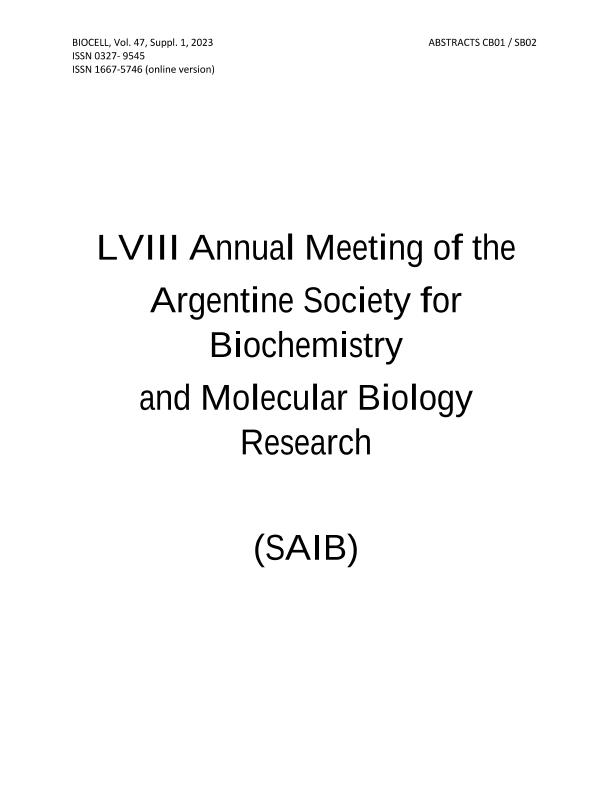Mostrar el registro sencillo del ítem
dc.contributor.author
Principe, Gabriel

dc.contributor.author
Lezcano, Virginia Alicia

dc.contributor.author
Tiburzi, Silvina Mabel

dc.contributor.author
González Pardo, María Verónica

dc.contributor.other
Ceccarelli, Eduardo Augusto

dc.date.available
2024-02-27T15:50:38Z
dc.date.issued
2022
dc.identifier.citation
Anti-angiogenic and apoptotic actions of the natural flavonoid quercetin in a cellular model of Kaposi´s sarcoma.; LVIII Annual Meeting of the Argentine Society for Biochemistry and Molecular Biology Research (SAIB); Mendoza; Argentina; 2022; 1-2
dc.identifier.issn
0327-9545
dc.identifier.uri
http://hdl.handle.net/11336/228656
dc.description.abstract
Quercetin (QUE) is a flavonoid that belongs to the family of phytoestrogen and exhibits anticancer properties in multiple types of solid tumor; nevertheless, its effect on virally oncogenic transformed cells is less studied. The viral G Protein-Coupled Receptor (vGPCR) is one of the molecules from the lytic phase of herpesvirus-8 able to induce cellular modifications through a paracrine oncogenic signaling cascade in Kaposi?s sarcoma. We preliminary showed that QUE exerts antiproliferative effects on endothelial cells that stably express vGPCR. In this work, we further explore the mechanism of QUE-induced cell death in vGPCR cells. First, the IC50 of QUE was calculated by crystal violet technique after the treatment of SVEC and vGPCR cells with different concentrations of QUE (1-100 µM) or vehicle (0.1% DMSO) for 48 h. We found that SVEC cells (IC50= 14.09 µM) were more susceptible to QUE treatment than vGPCR cells (IC50= 30.078 µM). Herein, 30 µM of QUE was selected to further characterize the cell death of vGPCR cells. Cell cycle analysis revealed that QUE increase sub G0 phase and reduce S phase of vGPCR treated with QUE for 24 h presuming an apoptotic event. Annexin V/PI stain and caspase-3 activity confirmed that apoptosis takes place in vGPCR cells after QUE treatment. The vGPCR activates and controls the HIF-1α transcription factor promoting the expression of pro-angiogenic molecules such as VEGF. Consistently, qRT-PCR studies indicated that QUE downregulates the expression of HIF-1α and VEGF mRNA in a concentration dependent manner. In conclusion, our findings from this study suggest that QUE promotes its anticancer effects triggering both, anti-angiogenic and pro-apoptotic, program to induce the cell death of the vGPCR cells.
dc.format
application/pdf
dc.language.iso
eng
dc.publisher
Tech Science Press
dc.relation
https://newsite.saib.org.ar/congreso2022/
dc.rights
info:eu-repo/semantics/openAccess
dc.rights.uri
https://creativecommons.org/licenses/by-nc-sa/2.5/ar/
dc.subject
PHYTOESTROGEN
dc.subject
CELL DEATH
dc.subject
KAPOSI’S SARCOMA
dc.subject
SIGNALING
dc.subject.classification
Bioquímica y Biología Molecular

dc.subject.classification
Ciencias Biológicas

dc.subject.classification
CIENCIAS NATURALES Y EXACTAS

dc.title
Anti-angiogenic and apoptotic actions of the natural flavonoid quercetin in a cellular model of Kaposi´s sarcoma.
dc.type
info:eu-repo/semantics/publishedVersion
dc.type
info:eu-repo/semantics/conferenceObject
dc.type
info:ar-repo/semantics/documento de conferencia
dc.date.updated
2024-02-22T13:58:29Z
dc.journal.volume
47
dc.journal.number
1
dc.journal.pagination
1-2
dc.journal.pais
Estados Unidos

dc.journal.ciudad
Henderson
dc.description.fil
Fil: Principe, Gabriel. Consejo Nacional de Investigaciones Científicas y Técnicas. Centro Científico Tecnológico Conicet - Bahía Blanca. Instituto de Ciencias Biológicas y Biomédicas del Sur. Universidad Nacional del Sur. Departamento de Biología, Bioquímica y Farmacia. Instituto de Ciencias Biológicas y Biomédicas del Sur; Argentina
dc.description.fil
Fil: Lezcano, Virginia Alicia. Consejo Nacional de Investigaciones Científicas y Técnicas. Centro Científico Tecnológico Conicet - Bahía Blanca. Instituto de Ciencias Biológicas y Biomédicas del Sur. Universidad Nacional del Sur. Departamento de Biología, Bioquímica y Farmacia. Instituto de Ciencias Biológicas y Biomédicas del Sur; Argentina
dc.description.fil
Fil: Tiburzi, Silvina Mabel. Consejo Nacional de Investigaciones Científicas y Técnicas. Centro Científico Tecnológico Conicet - Bahía Blanca. Instituto de Ciencias Biológicas y Biomédicas del Sur. Universidad Nacional del Sur. Departamento de Biología, Bioquímica y Farmacia. Instituto de Ciencias Biológicas y Biomédicas del Sur; Argentina
dc.description.fil
Fil: González Pardo, María Verónica. Consejo Nacional de Investigaciones Científicas y Técnicas. Centro Científico Tecnológico Conicet - Bahía Blanca. Instituto de Ciencias Biológicas y Biomédicas del Sur. Universidad Nacional del Sur. Departamento de Biología, Bioquímica y Farmacia. Instituto de Ciencias Biológicas y Biomédicas del Sur; Argentina
dc.relation.alternativeid
info:eu-repo/semantics/altIdentifier/url/https://www.techscience.com/biocell/v47nSuppl.1/50703
dc.conicet.rol
Autor

dc.conicet.rol
Autor

dc.conicet.rol
Autor

dc.conicet.rol
Autor

dc.conicet.nroedicion
1
dc.coverage
Nacional
dc.type.subtype
Congreso
dc.description.nombreEvento
LVIII Annual Meeting of the Argentine Society for Biochemistry and Molecular Biology Research (SAIB)
dc.date.evento
2022-11-08
dc.description.ciudadEvento
Mendoza
dc.description.paisEvento
Argentina

dc.type.publicacion
Journal
dc.description.institucionOrganizadora
Sociedad Argentina de Investigaciones en Bioquímica y Biología Molecular
dc.source.revista
BIOCELL
dc.date.eventoHasta
2022-11-11
dc.type
Congreso
Archivos asociados
